Paper Spider Webs Ideas

As we explore the fascinating world of paper spider webs, we're struck by the endless possibilities for creative expression. By mimicking the intricate structures of natural spider webs, we can craft our own unique designs that capture the beauty and complexity of these eight-legged wonders. From experimenting with different paper textures and widths to recreating the mesmerizing sparkle of morning dew, the possibilities are endless. But just as we think we've mastered the art of paper spider webs, we're left wondering: what other secrets can we uncover to take our designs to the next level?
Key Takeaways
- Create a hexagonal framework on paper using silken threads to maximize strength and stability, inspired by spider webs.
- Use radial threads to provide primary structural support and spiral threads to form the web's outer rim, distributing stress evenly.
- Employ different types of paper threads with varying strength, elasticity, and stickiness to mimic spider silk's unique properties.
- Design intricate corner patterns and anchoring techniques to secure the paper web, utilizing available space to create complex patterns.
- Craft paper knots to secure the web, using compact, spiral knots for stability and robust, multi-loop knots for resistance to sagging.
Silken Threads Crisscross Walls

How do the intricate patterns of spider webs manage to cover entire walls in a matter of days? We're fascinated by the sheer scale and complexity of these natural wonders.
As we observe the process, we notice that spiders use wall anchors to secure their webs. These anchors are made of sticky silk threads that attach to the wall, providing a foundation for the web's framework.
The spider then weaves its artistic patterns, radiating from the center of the web. These patterns aren't just aesthetically pleasing; they're also functional, helping the spider to catch prey and sense vibrations.
We're struck by the precision and speed with which spiders can spin their webs. In just a few hours, they can cover a large area with intricate patterns, using different types of silk threads for strength, elasticity, and stickiness.
As we study the silken threads that crisscross walls, we're reminded of the incredible engineering skills of spiders. Their webs are a monument to their adaptability, resilience, and creativity.
Golden Threads Glisten Dawn
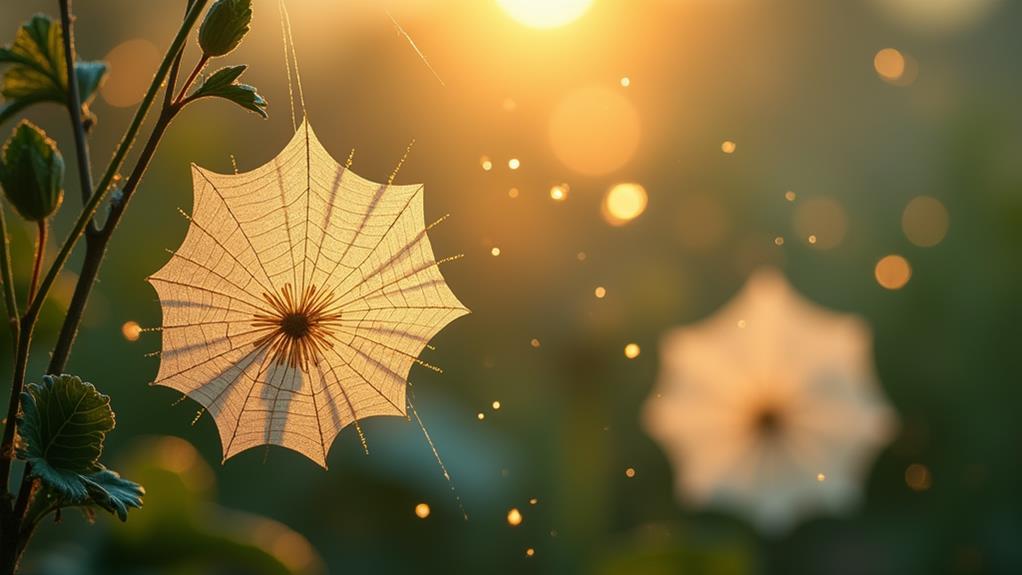
One hundred delicate threads glimmer in the morning light, as we observe the spider's masterpiece at dawn.
The golden threads, intricately woven, create a mesmerizing display of morning sparkle. As we examine the web, we notice the spider's remarkable ability to manipulate silk fibers to refract and reflect light. This phenomenon, known as diffraction, is responsible for the dazzling display of colors we see.
At dawn, the web is at its most breathtaking, as the soft, golden light accentuates the delicate patterns and enhances the Dawn beauty.
We can't help but marvel at the precision and accuracy with which the spider constructs its web. Each thread is carefully placed to maximize the capture of prey, while also ensuring the structural integrity of the web.
The result is a masterpiece of engineering and artistry, one that inspires awe and admiration. As we continue to study the web, we're struck by the intricate details and the spider's remarkable ability to create something so beautiful and functional.
Delicate Patterns Adorn Corners
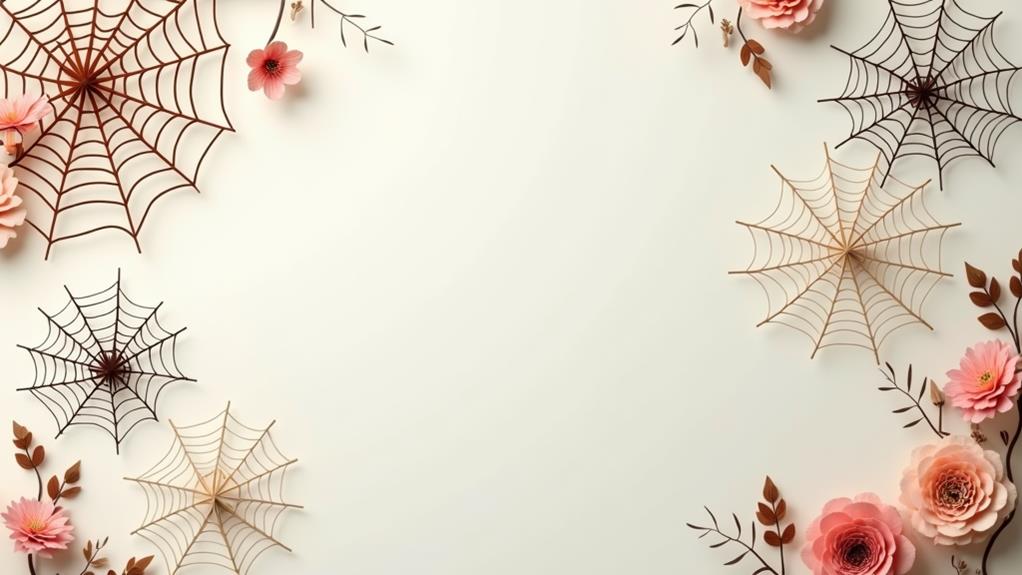
Corners, often overlooked, are where the spider's mastery of pattern-making truly shines.
We find that the intricate corner details are a tribute to the spider's ingenuity, as they cleverly utilize the available space to create complex patterns.
These patterns serve as a rich source of inspiration for our paper spider webs, as we aim to replicate the spider's precision and attention to detail.
Upon closer inspection, we notice that the spider's corner patterns often feature a combination of radial and circular threads.
These threads intersect and overlap, creating a mesmerizing display of geometry and symmetry.
We can draw pattern inspiration from these intricate designs, experimenting with different thread arrangements and densities to achieve a similar level of complexity.
Fragile Threads Anchor Corners
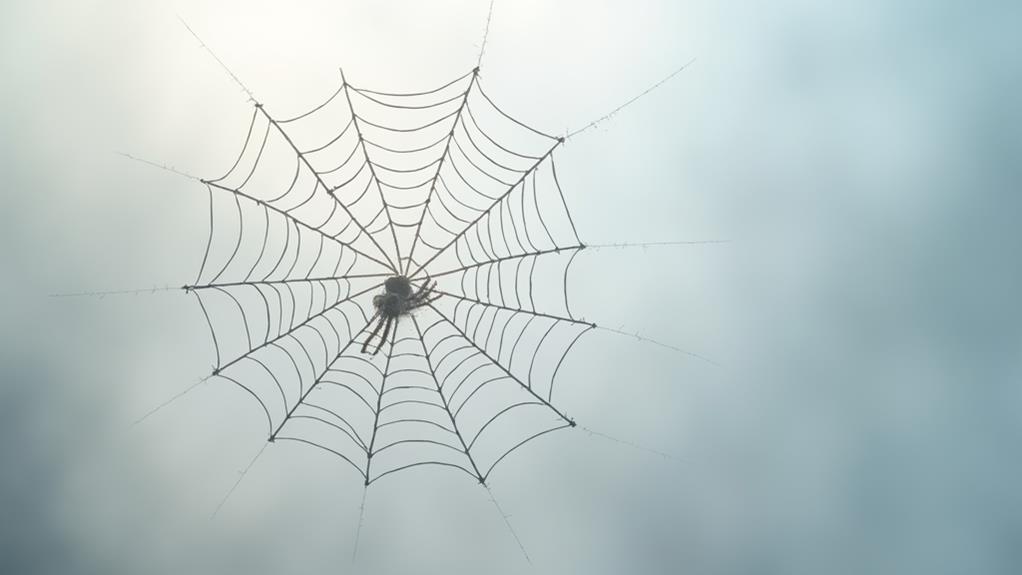
We're drawn to the spider's clever use of fragile threads to anchor its webs in place, a strategy that allows the web's intricate patterns to shine.
This approach not only certifies corner stability but also showcases the thread's resilience. By using fragile threads, the spider can create a delicate yet robust structure that withstands environmental stressors.
To anchor its web, the spider employs several techniques:
- Thread tensioning: The spider adjusts the thread's tension to optimize its anchoring capabilities.
- Corner reinforcement: Additional threads are placed at corners to provide extra support and stability.
- Anchoring points: The spider selects strategic locations to anchor its threads, guaranteeing maximum hold.
- Thread weaving: The spider weaves threads in a specific pattern to distribute stress evenly and enhance corner stability.
Intricate Knots Secure Webs
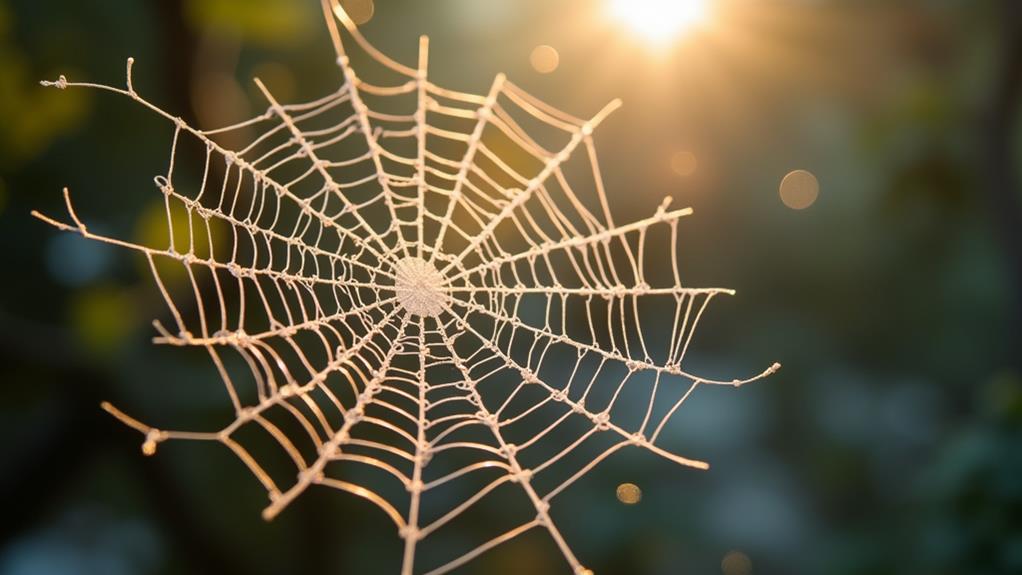
We marvel at the intricate knots that spiders craft to secure their webs, showcasing their remarkable engineering prowess.
These knots are more than just tangled threads; they're precision-crafted structures that withstand environmental forces and prey struggles.
In our web architecture study, we've found that spiders employ various knot types, each designed for specific web regions and functions.
For instance, the sheet web's foundation lines feature robust, multi-loop knots that resist sagging, while the orb web's radial threads rely on compact, spiral knots for stability.
To better understand these knots, we conducted a knot strength analysis.
Our research revealed that spider knots exhibit exceptional mechanical properties, such as high tensile strength and resistance to slippage.
By analyzing the knots' microstructure, we discovered that spiders cleverly manipulate thread tension, twist, and curvature to create these remarkable fasteners.
Sticky Droplets Hold Tight
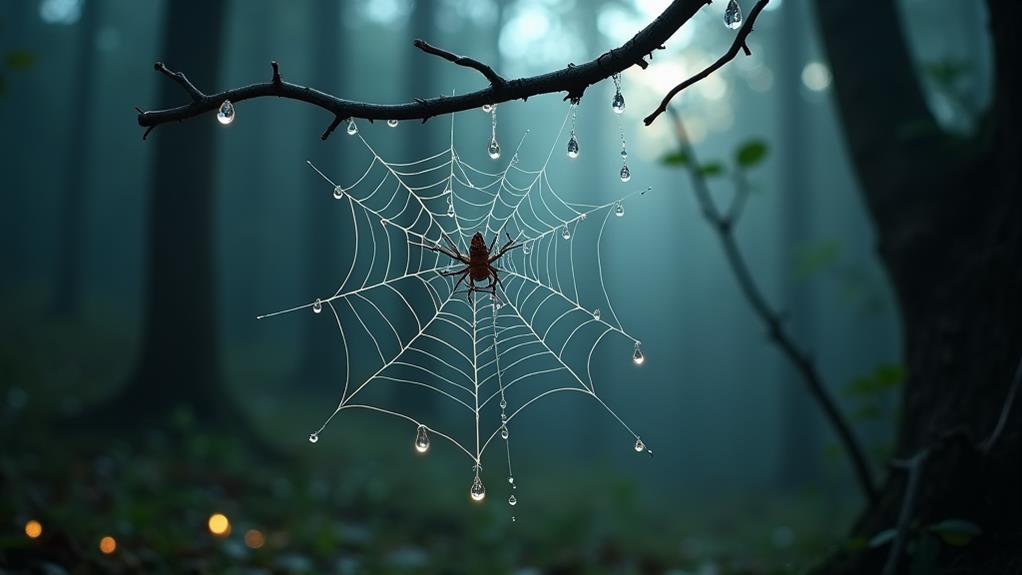
As we explore the intricate mechanisms that hold spider webs together, our attention turns to the sticky droplets that play a vital role in securing these structures.
These tiny droplets, formed through the process of droplet formation, are responsible for entrapping prey and maintaining the web's structural integrity.
- Surface tension: The droplets' surface tension allows them to maintain their shape and adhere to the spider silk, ensuring a strong bond.
- Viscoelastic properties: The droplets' viscoelastic properties enable them to absorb and dissipate energy, making them resistant to mechanical stress.
- Adhesive properties: The droplets' adhesive properties allow them to bind to a wide range of surfaces, including the spider silk and potential prey.
- Microscale size: The droplets' small size enables them to distribute evenly across the web, maximizing their effectiveness.
Silken Threads Form Hexagons
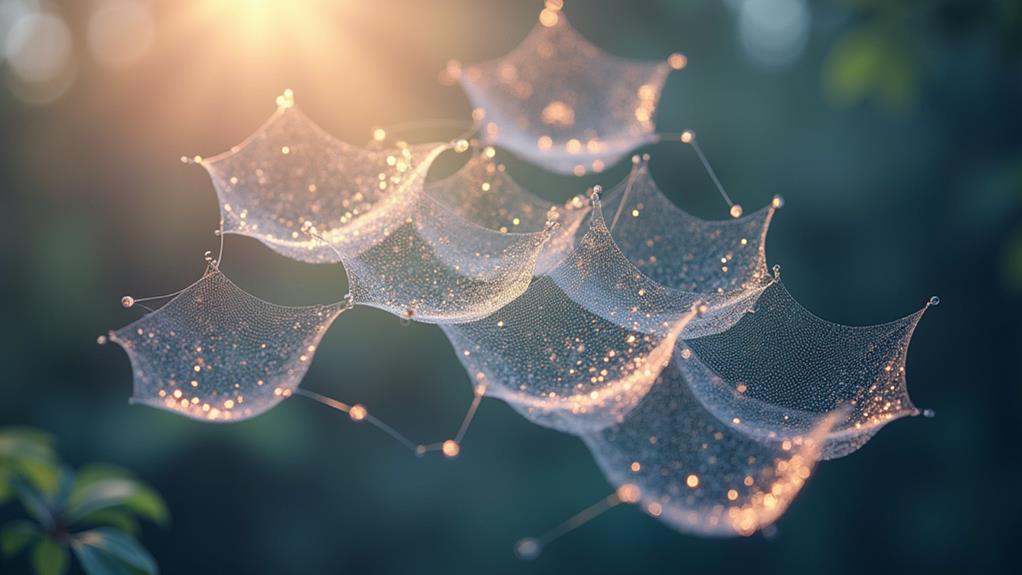
The intricate patterns of spider webs owe their remarkable strength and stability to the silken threads that form the hexagonal framework.
As we explore further into the web structure, we find that these threads aren't randomly arranged, but rather, they're precisely positioned to maximize thread tension.
This tension is vital in maintaining the web's integrity, allowing it to withstand external forces like wind and prey impact.
We observe that the hexagonal framework is composed of radial threads that converge at the center of the web, connected by spiral threads that form the web's outer rim.
The radial threads provide the primary structural support, while the spiral threads act as a secondary reinforcement.
This clever arrangement enables the web to distribute stress evenly, allowing it to absorb and dissipate energy efficiently.
Radiant Threads Reflect Moonlight
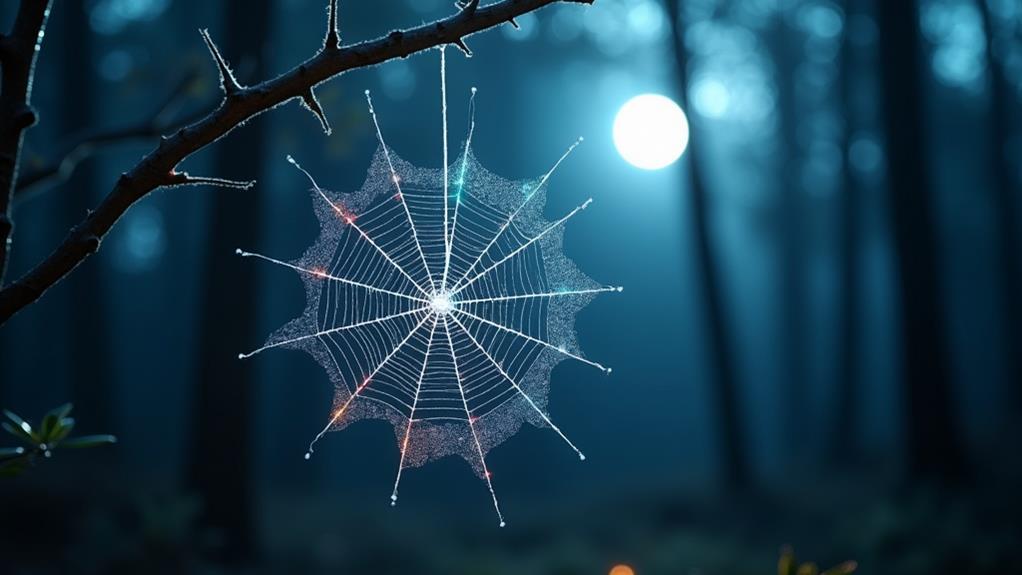
Frequently, under the soft glow of a full moon, spider webs transform into glistening, ethereal networks, as if infused with a magic that belies their intricate, organic architecture.
We marvel at the way these delicate structures seem to shimmer and glow, as if reflecting the moon's gentle light.
This phenomenon isn't just aesthetically pleasing, but also reveals the intricate properties of spider silk.
- Lunar whispers: The soft, whispery sound of spider silk vibrating in the moonlight is a result of the silk's unique molecular structure, which allows it to reflect and amplify sound waves.
- Refraction and reflection: The moon's light is refracted and reflected by the spider silk, creating a dazzling display of colors and patterns.
- Illuminated architecture: The intricate patterns and shapes of spider webs are revealed in stunning detail under the moon's gentle illumination.
- Biological brilliance: The combination of spider silk's reflective properties and the moon's soft light creates a truly breathtaking display of biological engineering.
As we gaze upon these radiant threads, we're reminded of the intricate beauty and complexity of the natural world.
Tiny Fibers Hold Dew

Our morning walks often reveal a hidden world, where spider webs have transformed into delicate, beaded necklaces, with dew droplets suspended from their intricate fibers.
As we observe these natural wonders, we're struck by the sheer precision of the spider's craftsmanship. The tiny fibers, typically measuring between 0.0005 and 0.01 millimeters in diameter, are strong enough to support the weight of individual dew droplets.
The morning sparkle of these webs is more than just aesthetically pleasing – it's a legacy to the spider's remarkable engineering skills.
The dew droplets, held in place by the web's sticky threads, refract and reflect light, creating a mesmerizing display of colors and textures. As we gaze upon these miniature marvels, we're reminded of the intricate relationships between light, water, and structure that govern our natural world.
The tiny fibers, so delicate yet so resilient, hold more than just dew droplets – they hold the secrets of the spider's remarkable adaptability and ingenuity.
Silver Threads Catch Shadows
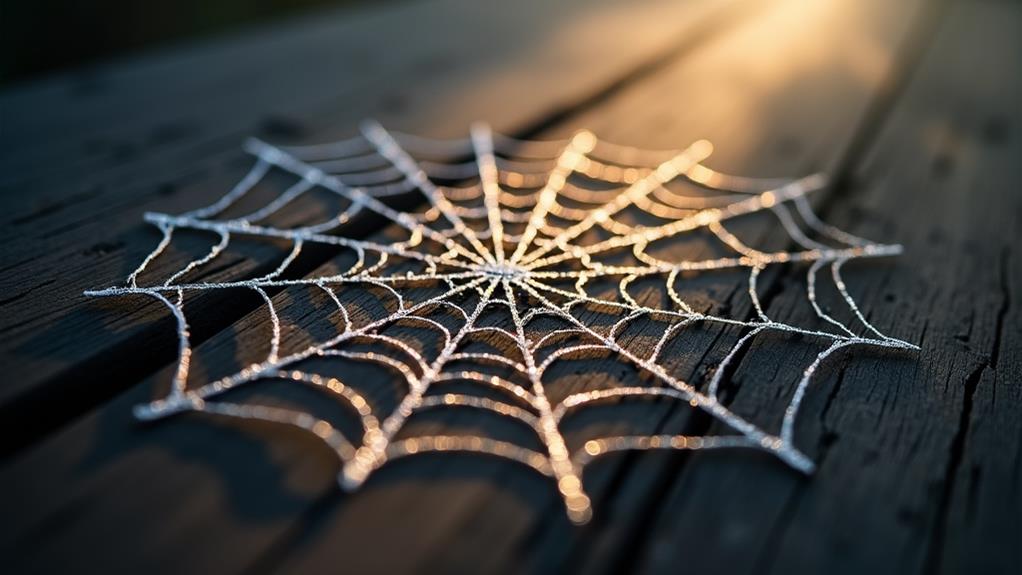
As morning light creeps across the landscape, we're drawn to the spider webs once again, this time to marvel at the silver threads that seem to catch shadows.
These glistening strands are a masterclass in optical illusions, creating an ethereal dance of light and darkness.
Here's what makes these silver threads so captivating:
1. Shadow dancing: The threads appear to move of their own accord, as if they're performing a mesmerizing waltz with the shadows.
This is due to the way the light interacts with the spider silk, creating an optical illusion that's both eerie and enchanting.
2. Light whispers: The gentle rustle of the threads as they respond to the morning breeze is almost imperceptible, yet it adds to the overall sense of enchantment.
It's as if the light itself is whispering secrets to the spider web.
3. Microscopic marvels: Under a microscope, the silver threads reveal their intricate structure, comprising tiny fibers that refract and reflect light in dazzling ways.
4. Nature's artistry: The spider web's ability to catch shadows and create an otherworldly atmosphere is a testament to nature's own artistry, reminding us that sometimes the most breathtaking creations are those found in the natural world.
Iridescent Threads Shimmer Softly
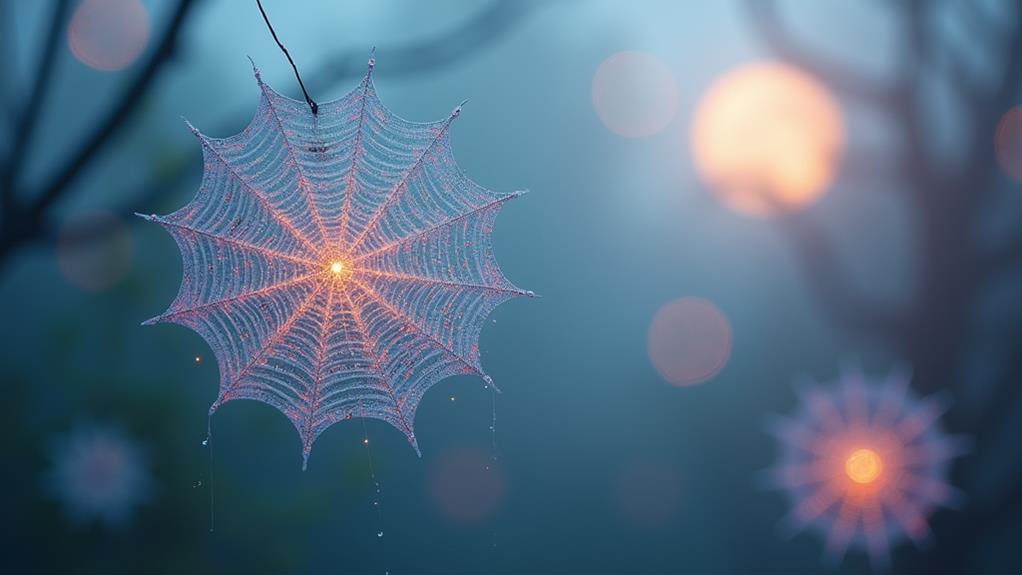
Several thousand iridescent threads shimmer softly within each spider web, casting a kaleidoscope of colors that seem to shift and change as we gaze upon them.
This phenomenon occurs due to the way light interacts with the microscopic structure of the spider silk. The silk's unique properties, such as its cylindrical shape and nanoscale ridges, refract and scatter light, producing iridescent hues.
As we observe the web, we notice that the shimmering effects are more pronounced when the light hits the threads at specific angles.
This is because the spider silk's nanostructures create a phenomenon called thin-film interference, where light waves overlap and cancel each other out, resulting in an array of colors. The iridescent threads appear to change color as we move around the web, creating an mesmerizing display of light and color.
Conclusion
As we've explored, paper spider webs offer a mesmerizing world of creative possibilities. By mimicking nature's intricacies, we've discovered how to craft stunning, hexagonal frameworks with radial and spiral threads. Varying paper strips, textures, and iridescent additions have allowed us to replicate the spider's silk threads and morning sparkle. From delicate corner patterns to intricate knots, we've mastered the art of anchoring and securing our webs. Now, we're ready to spin our own masterpieces, infusing them with scientific precision and artistic flair.







